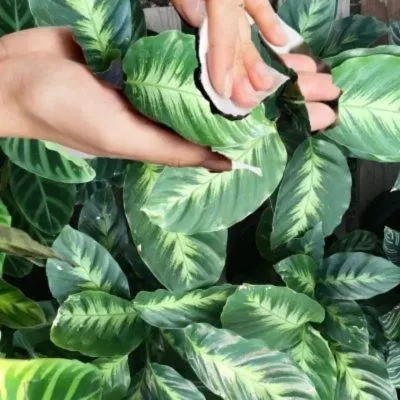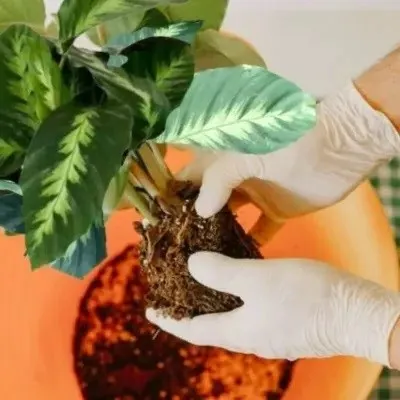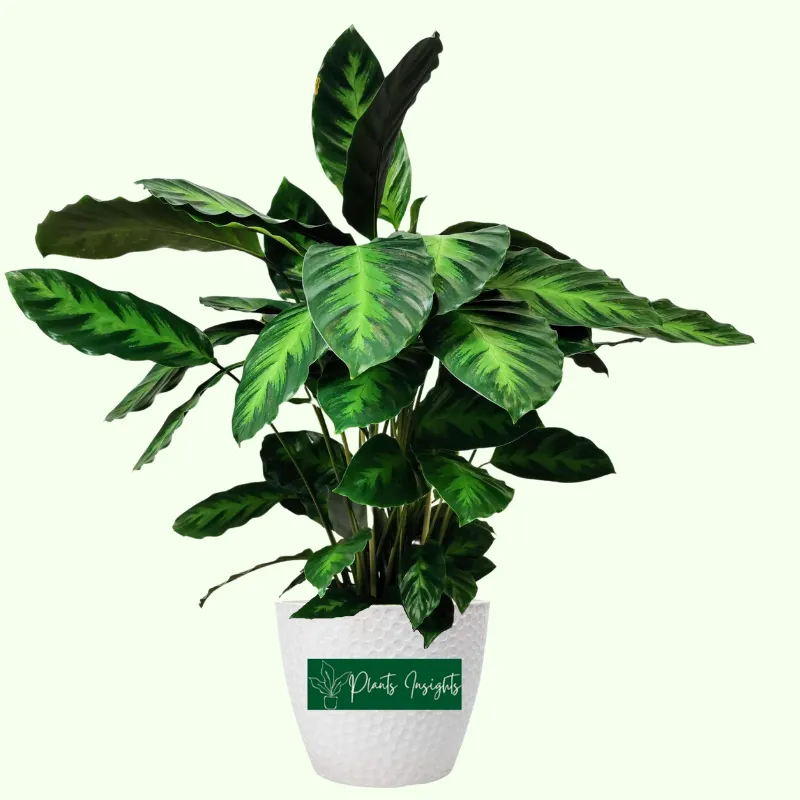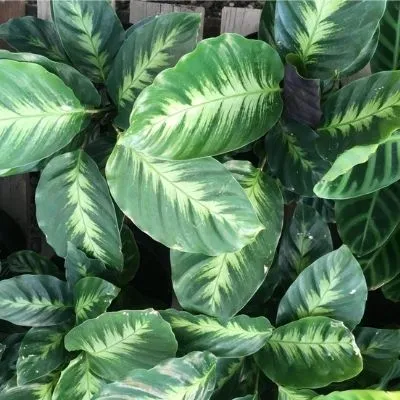Calathea Misto is a variant of Calathea Louisae. It’s a fantastic plant with a maximum height of 3 feet long and almost 3 feet wide. At first glance, the foliage seems to be hand-painted with cream-colored rough strokes throughout the midrib. In contrast, the underside of the leaf is a deep purple which enhances the aesthetic appeal of its surroundings. In addition, stunning patterns on the dark green foliage add an artistic look to the plant.
Calathea Misto is a photoperiodic plant that responds to the light throughout the day and folds its leaves at night. This movement causes a vast misconception that Calatheas are “Prayer Plants”, which in reality, they are not.
Prominent Family Members: Calathea White Star, Calathea Leopardina, Calathea Fasciata, Calathea Roseopicta, Calathea Flamestar, Calathea Lutea, Calathea Freddie
Essential Products:
How do you care for a Calathea Misto?
Calathea Misto care requires high humidity, a shaded area, required temperature to flourish and stay healthy. Furthermore, moist soil rich in nutrients will boost its growth. Let us go through the plant’s peculiar requirements in detail and learn to mitigate the common issues related to the Misto plant.

Bringing plant home
You must be excited about adding one more Calathea to your collection but wait! Before adding it to your home decor, make sure it is free from pests and diseases. Please check your plant leaves undersides and stem joints for pests, as pests usually make colonies there. Additionally, When the bacterial or fungal disease spreads, it appears as a spot on the leaves. Therefore, keep the new plant separate for two weeks from other houseplants as a precaution. If the plant doesn’t show any pest or disease sign during this period, add it to your home decor.
Beautiful foliage of Calathea Misto

What is the light requirement for Calathea Misto?
Calathea Misto is a hybrid cultivar with its origin in tropical Brazilian rainforests. They grow under the shade of tall trees canopies, which defuse the intense direct sunlight to plants. Direct sunlight can burn the leaves or at least fade the lush green color of the foliage.
Try to provide the same atmosphere as the Brazilian rainforests. Keep your plant indoors near the east or west-facing windows.
If you want to plant Calathea Misto outdoor, make sure it sits under the tree to have enough shade to avoid intense sunlight or artificially provide shade with shade cloth which is widely available at gardening stores. While buying shade cloth, please ensure it has enough ventilation and effusion of light capability.

Humidity and Temperature Requirements
Calathea Misto is native to the Brazilian rain forest, where a hot and humid climate boosts their growth and enhances the bright green and cream color of foliage extraordinarily. The ideal humidity level is 60-70% for its perfect growth. Moreover, if leaves tips turn brown and the edge becomes crispy, then for sure, Calathea Misto is present in a less than 50% humid environment.
To maintain the required moisture in the atmosphere, use a humidifier or group all indoor plants at a spot. Similarly, Misting and Pebbled water-filled trays are good options for adding moisture to the air; however, misting has its drawbacks if water droplets stay on leaves for an extended duration.
Temperature also plays a vital role in Calathea Misto’s growth. At 65 to 85 ℉, they thrive ideally. Protect them from the severe hot or cold air as they will start losing their turgidity.

How often should I Water Calathea Misto?
Misto plant flourishes if soil moisture remains constant throughout the year. A good watering routine will keep the soil moist. However, always avoid overwatering Calathea Misto plant hates soggy or waterlogged soil.
Water your Calathea Misto twice a week or when an upper two-inch layer of pot soil becomes dry. Use a finger or a moisture meter to know whether the soil is moist or not. Then water accordingly to the soil moisture condition.
Furthermore, the growing season starts from early spring to late summer. Water requirements increase during this period than in winter. In winter, watering the plant once a week will be enough as the plant is in the dormancy stage, and no growth happens.

Soil Requirement for Calathea Misto
Calathea Misto loves to flourish in moist soil; you shall always choose moisture absorbing and well-draining soil mixture. You can make your soil mix by combining 50% potting soil, 20% Charcoal, and 20% Orchid bark with 10% perlite to get the optimum results.
Excessive soggy soil (wet) or soil dryness is harmful to plant growth and health.

Pruning and Maintenance of Misto Plant
Pruning is a process of cutting away the parts of plants to promote new growth or disease control. Calathea Misto does not have any particular pruning requirement other than removing the dead or infected leaves from the plant.

Cleaning of Calathea Misto
The pruning will help you maintain the shape and size of the plant. Always use a sterilized and sharp knife or scissor for pruning.

Does Calathea require fertilization?
Fertilizers boost growth and provide extra nutrients to the plant. Fertilize your plants every month in the growing season, from spring to late summer.
Use nitrogen-based fertilizers with an equal ratio of potassium and phosphorus for Calathea Misto plants, widely available at gardening stores. Follow the instructions on the packet to get the best results.
Avoid over-fertilizing your plants as it will burn the plant leaves. Furthermore, do not fertilize the Misto plant during the autumn and winter.

Repotting the Calathea Misto
Repotting is necessary for the plant’s continual growth if it becomes root-bound. A root-bound plant will have stunted growth and eventually develop roots issues and diseases.
Following is the simple guideline to repot your plant.

Propagation of Calathea Louisae Misto
You can propagate your Calathea Misto plant at home by dividing the mother plant’s roots, and the best practice is to propagate your plants while repotting.
Follow these steps to propagate the Calathea Misto Plant

Is Calathea Misto Toxic?
Calathea Misto is a non-toxic pet-friendly plant family; feel free to let your kids and pets play around with the plants. Research proved that these plants are non-toxic when ingested by humans or pets.

Diseases and pests of Calathea Misto
Pests
Calathea Louisae is rarely infected by pests, especially when kept indoors. However, the new addition of a plant from the nursery can bring several pests like Spider Mites, Whiteflies, Thrips, Scale, and Mealybugs. Moreover, Fungus Gnats love to lay eggs in moist soil, and if the infestation is severe, the larva can damage roots also.
Use the sticky traps to stop the spread of fungus gnats. To cure the pests feeding on leaves, apply Neem oil with a soft cloth on infected leaves, or spray pesticides.
Diseases
Overwatering will make the soil soggy, and roots are prone to fungal infection if they remain in wet soil. The first sign of root rot is plant’s leaves start turning yellow, and secondly, the leaves start drooping, and wilting occurs. Bring out the plant from the pot, cut off the rotted roots, and replant the Calathea in moist soil with antifungal treatment.

Root rot of Calathea Misto
In addition, a bacterial leaf spot can be seen if your plant foliage remains wet after misting. The medication for Pseudomonas bacteria is to wash out the leaf with antibacterial soap and always wipe out extra water from the leaves after misting to protect the plant from the next bacterial infection.









